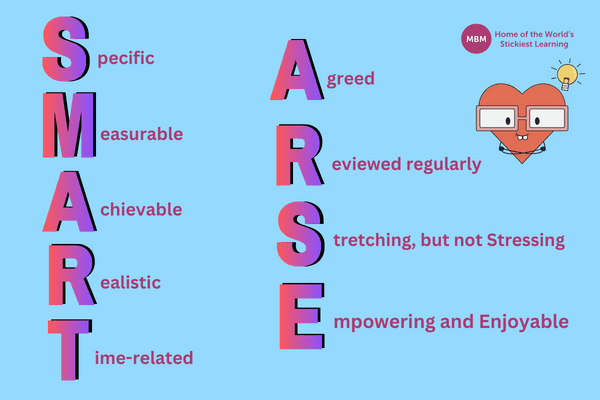How to Create SMART Objectives
In any business, regardless of your sector or industry, every company needs to have goals and objectives to work towards. These targets are the roadmap we follow to achieve success in different areas, such as finance, customer satisfaction, employee engagement and development, etc. This is where knowing how to prepare and use SMART objectives is an important skill to develop and apply.
Having covered this topic in many of my leadership training sessions, I know from experience that many people have heard of the concept. However, what I also found is that many don’t quite understand how to use each of the elements correctly.
Therefore, we are here to explain what we mean by SMART objectives, show examples of how they contribute to clear and concise objective setting, and other useful tips to get those goals achieved more effectively.
SMART Objectives Overview

So, SMART objectives are useful in project management, employee performance management, and personal development, among other things. SMART stands for:
- Specific
- Measurable
- Attainable
- Relevant/Realistic
- Time-bound
Peter Drucker, a writer on the subject of management, and George Doran, a management consultant, are the pioneers of the concept of SMART objectives. It is George Doran in particular who first explained it in terms we know today. He did this in the paper, “There is a SMART Way to Write Management Goals and Objectives.” The Management Review Journal published this article in November 1981.
Another management expert who contributed to the idea is Edwin Locke. He began examining goal setting in the mid-1960s. In particular, Locke relied on Aristotle’s form of final causality (that purpose could cause action) to build on it. Moreover, he researched the impact goals have on human activity.
In 1968 Locke published his first article, “Toward a Theory of Task Motivation and Incentives.” In it, he established a positive relationship between clearly identified goals and performance. SMART scholars have since borrowed substantially from his work.

>> Caroline Online Coaching Cards <<
Understand Goals v’s Objectives
When we look at using SMART, we are speaking specifically about setting SMART objectives rather than goals. Just to give a brief explanation of the difference between goals and objectives.
Goals
Here, we see a broad overview of what we want to achieve. It can be a short or long-term desired result that we are aiming for. The goals we set for ourselves don’t have to have specific details or measures. Instead, they are the broad outlook for the team or company moving forward. Some specific elements of goals are:
- Look at the big picture of what you want to achieve.
- Tend to be long-term plans.
- Do not have to be specific.
- Measures are not a requirement.
Objectives
Here, we see the more specific steps that we need to take in order to achieve our goals. Without these clear objectives, there will be no real direction for the team to follow. We won’t properly understand the steps that are required to achieve the main goals.
Therefore, in comparison to goals, we see:
- Specific steps that help make the big picture clear.
- Very specific details of how to achieve the goals.
- Must be measurable.
- Can be short-term as multiple objectives can contribute to the overall goal over time.
Therefore, based on the above difference, SMART directly links with objectives rather than goals. Let’s have a look at the aspects of SMART in more detail.
The Following is the Breakdown of S.M.A.R.T:

1. Specific
A keen examination of organisational goals reveals the possibility of breaking them further into separate and more specific goals. However, to do these, you need to:
- Know who is involved.
- Know what you want to accomplish.
- Identify the where; location.
- You need to establish the when; time frame.
- You should identify which requirements and constraints will affect your progress.
- You should know why you need to achieve the goal.
For instance, a company’s goal can be:
‘We aim to increase sales for our business with our supermarkets.’
This goal lacks specificity. Also, the quantity of increase and a deadline (period) are missing.
Instead, an example of a SMART objective would be:
‘We aim to increase sales by +14% with Tesco by December 2016.’
2. Measurable
A concrete criterion for measuring progress toward the attainment of a goal is essential. Indeed, if a goal is not measurable, ascertaining your team’s progress towards achieving a goal is difficult. Measuring progress is necessary to keep the team on track and help it beat deadlines.
The unmeasurable goal sounds like this:
‘Gain more shoppers for our category by promoting more.’
This is a worthy goal. However, how would you know if the promotions were assisting in getting more shoppers?
A metric to measure the result of promoting more within the SMART objectives could be:
‘Gain 1,000 more shoppers per promotion than when a similar promotion happened, as measured by Kantar.’
3. Achievable
To attain a goal, there should be the capacity to deliver it. What’s more, you should avail the necessary resources, and the workload should accommodate the new requirements. If resources are limited or the workload is non-stretchable, then lowering the goal or addressing resource constraints is essential.
A typical goal could be:
‘Increase sales by 50%’.
This doesn’t belong in the category of SMART objectives.
Instead, it could be:
‘Increase sales by 11%.’
4. Relevant/Realistic
A goal should be realistic to the confines of a person’s job. Realistic, considering their pressures. Possible to achieve within the timescales that they have to do it within.
The other way to see ‘R’ is as Relevant. Support, or be in alignment with other goals in an organisation. A quick analysis of what you need to achieve determines the relevance of a goal. Reviewing a goal to ascertain if it is in tandem with or against the organisation’s mission or objectives is important. A relevant SMART objective is set within the working environment and enhances a person’s knowledge, skills, or attributes (KSA). These bring overall benefits to the organisation.
A typical goal could be:
‘Refurbish the category equipment in-store on our category. ‘
This goal does not adhere to the ‘Realistic’ of SMART objectives.
Instead, it could have been:
‘Audit the equipment in-store to see whether it is still fit for purpose.’
5. Time-Bound
Having a timeframe for attaining a particular goal is important. Indeed, a commitment to a deadline helps a team focus their efforts towards the completion of the goal. Even more, this prevents the overriding of unrelated routine tasks that may arise to the disadvantage of the goal. A time-restrained goal establishes a sense of urgency that inspires action. Considering all priorities and time constraints is necessary for setting a realistic deadline. If outside pressures make the deadline unrealistic, changing the strategy is important. For example, some tasks associated with the goal can be outsourced.
A Time-Bound goal could be:
‘Achieve a category market share of 26% on the 4-week data by the 31st of April 2017, as measured by Kantar.’
Test Your SMART Objectives
Our ready reckoner, below, is a great way to check whether your objectives are truly SMART. Click the image below for a higher-resolution version:

Obstacles to Developing SMART Objectives and How to Overcome Them
Few team leaders don’t know about the concept of SMART objectives. Nevertheless, many don’t use it in their organisational planning. The following are some of the obstacles that could stand in your way of developing SMART objectives:
#1. Fear of Not Knowing
Many of the learners we speak with respond with a ‘Yeah, I know what SMART objectives are’, and have a sure and adamant tone. Yet, when we explore using SMART, most are unable to write a SMART target. ‘SMART’ can be like an Auntie. They are a relation so you ‘know’ them, but when you are encouraged as a kid to go and talk to Auntie, you realise you never really knew them at all.
Applying SMART to an objective is hard because you thought you knew it and finding out that you never really did can be hard to admit. Admitting it and then writing your first SMART objective can be liberating because you now have something that cannot be wriggled out of or discussed in the grey. It is clear and the person you have given the SMART target to knows even before they come back and see you, that they have either not achieved it or achieved it. No longer is it a subjective discussion. It is now tangible and objective.
#2. Fear of Committing
Setting vague goals is one way of remaining within our comfort zones. That is because we know that in the end there is nothing to show whether we achieved our goal or we didn’t. For instance, stating that you will grow your business within the year sounds nice but doesn’t commit you so that if it doesn’t happen anyone can point it out.
The fear also comes because we might feel we aren’t in control of all of the variables that might affect the outcome.
You have to commit if you want to succeed in your projects. Setting SMART objectives is to some extent like landing in a foreign land and burning the boats before a battle. You either conquer or die (stand the humiliation of failure). This is a huge motivation to succeed.
#3. Fear of Failure
Closely linked to the fear of committing is the fear of failure. You might feel that setting up clear goals is exposing yourself and your team to pressure to deliver, which might result in disappointment and the death of morale.
However, you should note that some aspects of the SMART concept protect you from these negative results. By setting up measurable goals, you can define what is achievable. With that said, starting small is the best way to develop confidence.
Develop SMART objectives for a day. There isn’t a lot to lose in a day-long goal, but there is a lot to learn about the effectiveness of this strategy. You can extend this to a week, month, year and, later, even a five-year period.
#4. Underestimating the Power of Planning
It is possible to know about SMART objectives but fail to grasp the power it possesses in planning. This is especially true if the team leader has never experienced the results of SMART planning before. The place to start in overcoming this obstacle is to take time, as the team leader or even the entire team, to study case studies involving setting SMART objectives.
Published case studies on SMART goal setting can help you and your team to grasp a few fundamentals. However, the most convincing route is to start small. If daily SMART objectives work, the weekly ones will work and so will the monthly, yearly and even five-year period ones.
#5. Skill and Resource Constraints
Just like any other undertaking in an organisation, you need the right resources to formulate effective and fruitful SMART objectives. If you lack, especially skills, you may know about the SMART concept, but you will find yourself not using it.
To counter this problem, you should make it part of the requirements when you are hiring that the candidates have the training or work experience in strategic planning, including SMART objective development. The other way to go about it is to organise in-house training. You can invite an expert in this area to take your team through the process of coming up with specific, measurable, achievable, relevant and time-bound goals.
Extending ‘SMART’ Objectives to ‘SMARTARSE’

This extension of SMART objectives brings concepts of quality to the goal. ‘ARSE’ stands for:
- Agreed
- Reviewed regularly
- Stretching, but not Stressing
- Empowering and Enjoyable
6. Agreed
A goal can be smart, but without a team that has agreed to implement it, achieving it will be difficult. Agreeing to work as a team will synchronise efforts, reduce conflicts, and inspire collective effort. When a team agrees, the completion is quick, and this creates a sense of accomplishment among all actors.
7. Reviewed Regularly
Putting in place regular reviews will help you to identify any additional help and support required. You need to create a timetable with your team for regular meetings. You should also encourage informal chats about the progress of the project.
8. Stretching but Not Stressing
Setting stretch goals creates the danger of setting goals that may be impossible. This could easily bring in stress. Steve Kerr, who was a Chief Learning Officer at Goldman Sachs and General Electric, said of stretch goals:
“If done right, a stretch target …gets your people to perform in ways they never imagined possible. Stretch targets are an artificial stimulant for finding ways to work more efficiently. They force you to think out of the box.”
According to the MIT Sloan School of Management, stretch goals are difficult to achieve and can have dysfunctional effects. Performance below aspirations increases the probability of stress and job dissatisfaction.
9. Empowering and Enjoyable
If you want to succeed, you need to set goals. Without goals, you lack focus and direction. Goals provide you with a benchmark for determining whether you are actually succeeding or not. Success empowers team members. However, that can only happen if they enjoy doing the work. They should not feel coerced and exploited. Workers who enjoy their work will be optimistic, and creative, learn faster, and make better decisions.
By using SMART objectives, managers can ensure both long-term and short-term focus and success. Team management and coaching are essential soft skills for managers. These soft skills require SMART goals. Similarly, hard skills also need SMART objectives. They are also useful in career planning, human resource management, personal financial planning, and brainstorming.
SMART Objectives Analysis
Goals assessment should be broad and involve many aspects to ensure that its achievement will benefit the organisation. Performance management specialist, Professor Andy Neely advises that SMART analysis should involve the following tests:
- Truth test: Are you really measuring what you set out to measure?
- Focus test: Are you only measuring what you set out to measure?
- Relevancy test: Is it the right measure of performance?
- Consistency test: Will the data collection be the same?
- Access test: Is it easy to locate and capture the data needed to make the measurement?
- Clarity test: Is there a possible ambiguity when interpreting the results?
- So-what test: How will the action on data be?
- Timeliness test: Can data access be rapid and frequent enough for action?
- Cost test: Is the measure worth the cost of measurement?
- Gaming test: Will the measure encourage undesirable or inappropriate behaviours?
While setting personal SMART objectives, the tips above are enough. However, as a manager of a team, you need more. Read People Management Skills – The Ultimate Guide to Managing People, which will also equip you to lead your team to come up with SMART goals.
If you’re enjoying our content, support us on Facebook.
Updated on: October 18, 2023




